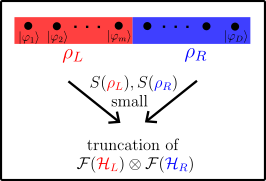QC-DMRG: Overcoming its Limitations
 A particularly refined way of exploiting the spatial locality of 1-dimensional lattice models is given by the famous density matrix renormalization group (DMRG) ansatz. The remarkable success of DMRG is based indeed on the reduced spatial correlations as described by the area law for the entanglement entropy: The spatial entanglement S between the left and right half of the lattice system (see figure) is significantly reduced compared to generic quantum states. Quite in contrast, the recent success of DMRG in quantum chemical systems (QC-DMRG) is rather astonishing: Why should the respective molecular Hamiltonians, expressed in second quantization with respect to a set of D orbitals, exhibit any local structure on the artificial 1-dimensional ''lattice'' formed by those orbitals?
A particularly refined way of exploiting the spatial locality of 1-dimensional lattice models is given by the famous density matrix renormalization group (DMRG) ansatz. The remarkable success of DMRG is based indeed on the reduced spatial correlations as described by the area law for the entanglement entropy: The spatial entanglement S between the left and right half of the lattice system (see figure) is significantly reduced compared to generic quantum states. Quite in contrast, the recent success of DMRG in quantum chemical systems (QC-DMRG) is rather astonishing: Why should the respective molecular Hamiltonians, expressed in second quantization with respect to a set of D orbitals, exhibit any local structure on the artificial 1-dimensional ''lattice'' formed by those orbitals?
One of our main goals is to explain the emergence of a local structure on the artificial lattice in QC-DMRG by tracing it back to a deeper origin, namely the universal conflict between energy minimization and fermionic exchange symmetry in systems of continuously confined fermions. Then, by using concise tools from quantum information theory we would like to propose a scheme for optimizing the artificial lattice to localize the interaction as much as possible. A particularly strong impact of such a scheme is expected for fermionic systems confined by a dominating external potential [1].
Besides the remarkable success of QC-DMRG for most atoms and molecules up to forty electrons, there are also a couple of limitations which we would like to overcome. For instance, to recover the important dynamic correlations we are working on hybrid approaches by combining QC-DMRG with ground state approaches suitable for recovering dynamic correlations (density functional theory or coupled cluster). Moreover, to avoid the increase of the effective correlation length in the huge virtual orbital spaces we are resorting to ansatzes beyond the matrix product states.
[1] Ö.Legeza, C.Schilling, Phys. Rev. A 97, 052105 (2018)

